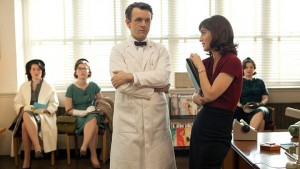
If you haven’t started watching Showtime’s new drama Masters of Sex, following the lives and work of sex pioneers Virginia Johnson and William Masters, you should really get on that. (Seriously, how often to do you get to watch a sex scene between people hooked up to machines with electrodes taped all over their bodies?)
But the show is more than titillating entertainment at its finest: Masters and Johnson — portrayed by Michael Sheen and Lizzie Caplan — were the first to really study what happens to the body during sex (hence the electrodes), so you’ll also get some important lessons on the inner workings of human sexuality while tuning in.
However, these innovators aren’t the only sexologists you should know about: Here are 10 more who also changed the collective conversation about getting it on.
1. Ernst Gräfenberg
This German physician advocated that there were ppleasure from places other than the P and the V. “Innumerable erotogenic spots are distributed all over the body, from where sexual satisfaction can be elicited,” he said in his 1950 paper on the subject. “We can almost say that there is no part of the female body which does not give sexual response, the partner has only to find the erotogenic zones.” (This guy knew what’s up.) But, Gräfenberg went down in history for one pleasure point in particular: In studying the role of a woman’s urethra as it pertains to orgasm he found that there was a sensitive spot in the anterior wall of the vaginal along the course of the urethra. Yes, the “G” in G-spot refers to him, after a sexologist coined the term as an homage to him in the 1980s.
2. Margaret Sanger
Take a moment to thank this woman every time you take your pill — she’s the reason you have it. A nurse and sex educator, Sanger opened the very first birth control clinic in 1916, founding what would later become Planned Parenthood (and she was arrested for doing so). She remains an icon of both women’s rights and sexual freedom: Thanks to The Pill, women who did not want to have children had a way to prevent pregnancy… and of course, it also allowed women everywhere to feel more liberated in bed.
3. Magnus Hirschfeld
This sexologist was an vocal advocate for sexual minorities and founded the Scientific Humanitarian Committee in 1897, the first organization of its kind to campaign for social recognition of gay, bi, and transgender people, and to protest against their persecution. While the Nazis destroyed the Berlin-based building the committee was housed in during World War II, the spirit of the organization lived on, paving the way for awareness and tolerance for those it supported, as well as future groups like GLAAD.
4. Sigmund Freud
Penis envy, the Oedipus complex, hysteria — Freud certainly gave us a lot to think about when it came to understanding desire, sexual and otherwise. While many of his theories were sexist (he maintained that women were inferior to men) he laid the groundwork for understanding sexual motivations through the lens of past experiences, particularly childhood. He also inspired other sexologists to expand upon his theories or prove him wrong. (Notably, psychoanalyst Karen Horney counteracted Freud’s theory that women wished to have penises with her theory of “womb envy,” a male desire to bear children, and was the first woman to study female psychology, publishing 14 papers between 1922 and 1937.)
5. Alfred Charles Kinsey
In gathering 18,000 people’s sexual histories over the course of his career — and publishing two comprehenvise volumes, Sexual Behavior in the Human Male in 1948 and Sexual Behavior in the Human Female in 1953 — Kinsey’s reseach revealed that oral sex, adultery, homosexuality, masturbation, and premarital sex were surprisingly common. Which, of course, pissed off a lot of people at the time. But by normalizing these so-called “perversions,” Kinsey’s highly controversial research on human sexuality laid the groundwork for modern sexologists. His Institute for Sex Research at Indiana University continues to operate, though it’s now known as the Kinsey Institute for Research in Sex, Gender, and Reproduction.

